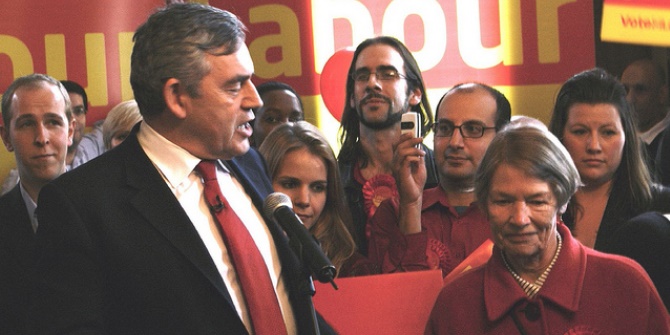 The media clearly have an impact in elections, but how far do they influence public opinion and the actual result? Sir Robert Worcester, and Jayme Herve take a close look at the impact of the print media in the run up to the General Election. The following is being presented at the BBC College of Journalism Seminar, “The Value of Journalism”, held at the LSE today.
The media clearly have an impact in elections, but how far do they influence public opinion and the actual result? Sir Robert Worcester, and Jayme Herve take a close look at the impact of the print media in the run up to the General Election. The following is being presented at the BBC College of Journalism Seminar, “The Value of Journalism”, held at the LSE today.
There’s always speculation (but little data) about the power of the media to influence events. Every since the claim that ‘it was the Sun wot won it’ after the 1992 election, and the quick counter-claim by Rupert Murdoch that it didn’t after all, there’s been argument and counter-argument about the role of the media. When it really counts is when there’s a close election, never more than in 2010. But what’s the evidence, now that the election is history?
The Sun officially endorsed the Conservatives on 30th September 2009. From then on it was dedicated to getting Brown out of office and the Tories back in Number 10. So, in 2010 was it ‘the Sun wot won it’?
Across the country, there was a 5 per cent swing from Labour to Conservatives between the 2005 general election and this year’s election on 6th May. However, among regular readers of the Sun the swing from Labour to Conservative was more than double, a massive 13.5 per cent.
Sun readers’ support for the Liberal Democrats between the elections rose from 12 per cent to 18 per cent, but that wasn’t much help to the LibDems as their national vote was 23 per cent in 2005 and again in 2010, no swing at all.
As a bonus for the Murdoch millions, readers of the Times went from 11 per cent Tory in 2005 to 27 per cent, a swing of 8 per cent.
Yet for all the influence the Sun purportedly wields, between 2005 and the time they endorsed Cameron, their readers had already swung 12.5 per cent. They’d led their newspaper before the word went out they should vote Tory.
What then happened?
Four Sun readers in a hundred swung back to Labour during the run-up to the election. But then during the election itself, between the 6th of April when the Prime Minister called the election and election day, five Sun readers in a hundred swung back to the Tories. This despite the daily hammering that the Sun delivered to the Labour campaign, its leadership and its focus.
On the first day of the election, 7th April, the photograph dominating the front page was of David Cameron with Big Ben in the background: the headline “D-Dave”. On day two, “Brown’s a Clown”. Day three, (Michael) “Caine: I’ll back Tories”, On the following Monday, “Help for kids of heroes” with Cameron’s photograph, and so on day after day, even on the day after the election, when the story was “Exit Poll puts Tories Ahead” on the banner, and a huge CAMERON WINS THE EXIT (sic) FACTOR headline. The lead story did by the way have the head ‘But it looks like a hung parliament’, based on the Ipsos MORI/GfkNOP exit poll which predicted 307 Tory seats. It was in fact, when Thirsk came in, 307, 19 short of a majority. Hung Parliament.
Among regular readers of the Times, there was a similar if somewhat modulated pattern. They swung 4 per cent to the Tories during the election, accounting for half the 8 per cent swing between 2005 and 2010.
More broadly, the 2010 general election was one of surprises. The first TV debate held on 15 May certainly changed the dynamics of the campaign and led to the most interesting election in the electorate’s memory, according to the post-election poll conducted by Ipsos MORI for the News of the World. Four people in ten, 41 per cent, said they found the 2010 election ‘very interesting’, which contrasts with just 12 per cent in 1997, the last time a government changed. Seven in ten said they believed the debates helped the process. Nearly ten million people watched the first debate at its peak viewing, and just over nine million was the average viewing figure.
So, did the TV debates act as a countervailing force to the influence of the red top newspapers generally and the Sun specifically? Not according to our analysis. Helping to balance the bias, among readers of the Daily Star, admittedly from a smaller readership and much less emphasis on election news and comment, before and during the election, while there was a ten percent swing to the Tories among Star readers from 2005 to 2010, the Star’s readers swung 11 per cent back to Labour during the month long election.
And despite the consistent strong support given to Labour by the Mirror, between the two elections their readers swung 6.5 per cent to the Conservatives. Overall, the ‘red tops’ swing between 2005 and 2010 elections was nearly double, 9.5 per cent, the national average, 5 per cent. Among broadsheets 2 per cent, and among the mid-markets, 4.5 per cent.
Yes, in the end there was a five percent swing to the Tories. It was widely remarked in the months in the run up that they needed 5.9 per cent to ensure an overall majority. The election began with the final pre-election polls showing a 5.5 per cent Tory swing, suggesting that a hung parliament was a distinct possibility. There were 91 polls during the election, triple the number five years earlier. The average of all 91, with fieldwork from the 7th of April to the 6th of May, was 5.6 per cent. A sandwich short of a picnic.
Jayme Herve








3 Comments